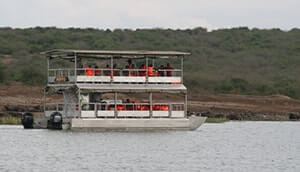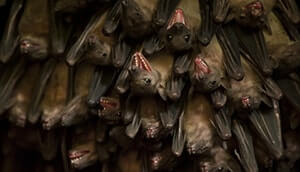Mweya Peninsula in Queen Elizabeth National Park.

A view of the Magnificent Mweya Peninsula in Queen Elizabeth National Park
Mweya Peninsula is a located within Queen Elizabeth National Park on the northeastern shores of Lake Edward at the corner where Kazinga Channel joins the lake. Mweya is about 66 kilometres by road south of Kasese town, the headquarters of Kasese district and the biggest town in that sub-region. Mweya Peninsula is the most visited place in Queen Elizabeth National Park, a privilege attributed to its amenities crowded close to its setting including Mweya Airstrip, accommodation facilities like the luxurious Mweya Safari Lodge, access to Lake Edward and Kazinga Channel plus the plentiful game on land, in the water and in the air. The geography, animals and plants around Mweya in the northern area of the park vary considerably from that in the Ishasha sector in the south.
Mweya Peninsular comprises of the Kazinga Channel Track, down to Katunguru gate, it then moves across to Kabatoro gate, with a bumpy ground cover with solid vegetation has dominated by Candlesticks Thorn. This thick plant life in reality makes Game watching pretty perplexing in this zone. However, the areas has lots of tracks for game viewing and are well maintained besides being followed properly by the park visitors.
Wildlife Viewing at Mweya Peninsula
The Mweya Peninsula is one of the best places to start your game drive from Nyamunuka Crater Lake. The area offers an assortment of game trails with many narrow natural animal tracks. A game drive through the area will give you a rational opportunity of finding the indefinable leopard plus herds of elephant. Mammals like hyenas, water bucks, buffaloes, warthogs and the giant forest hog are repeatedly spotted around the Peninsula. With is bordering with Kazinga Channel, hippos from the channel water grazing peacefully in the bushes can be seen any time of the day, from morning to evening. Countless bird species such as the Verreaux’s Eagle-Owl, Black Bee-eater and Malachite Kingfisher dwell in the peninsula.
Most of the Mweya guests earn pleasure by doing a 2-hour boat cruise on the remarkable Kazinga Channel. Queen Elizabeth National Park operates a bigger motorised vessel that runs two rides per day, one in the morning and another one in the afternoon. In addition, there are more cruises everyday depending on the number of visitors interested in the mesmerising voyage. To participate in the cruise, you first register at the park offices in Mweya. Boat Trips commence at the landing platform beneath Mweya Safari Lodge.
While at Mweya peninsula, you enjoy superb views over the water with sighting stretching over to Rwenzori Mountain ranges. Mweya is one of the finest places to see leopards which usually dwell in the little thickets and the area is focal base for activities in the attractive northern part of the park!
Landmarks
The Salient Features within and near Mweya include:
- Queen Elizabeth National Park headquarters
- Mweya Airstrip
- Kazinga Channel – a 34 kilometres (21 mi) canal linking Lake Edward to Lake George to the north east of Mweya.
- Lake Edward – A freshwater lake found in the Western Rift Valley. And Uganda-Democratic Republic of Congo border run directly via the middle of the lake.
Related Attractions in Queen Elizabeth National Park
Kazinga Channel is a 32-kilometre long water channel that connects Lake George in the east to Lake Edward in the west. The channel is among the most paramount geographical features in Queen Elizabeth National Park with a magnificent view of the most vital wildlife in the park.
Kyambura Gorge – The Home Chimps
Kyambura Gorge is found in the far eastern side of Queen Elizabeth National Park in south western Uganda is roughly 1 km across and about 100 meters deeper. The gorge also known as the ‘Valley of Apes’ is drained by River Kyambura. Its a habitat to chimpanzees, other primate species and birds as well.
The Ishasha Sector found in the Southern part of Queen Elizabeth National Park is well-known for the amazing Tree-Climbing lions. Lions that hang in the big fig trees are an exceptional attraction and a key highlight of any Uganda safari tour this large national park. The Ishasha lions relax in the tree branches as they also spy on their preys from above.
Kasenyi Plains are part of Queen Elizabeth National Park. It is at these plains that the biggest percentage of game drive Uganda Safaris are carried out from. The plains are found on the western shores of the spectacular Lake George adjoining to the Kazinga Channel onto which the water makes a convergence.
Lake George found in western Uganda covers 250 square kilometres. The lake with an estimated depth of 2.4 meters is part of Africa’s Great Lakes system. Though the lake itself is not considered a Great Lake. This water body was named after a British Prince, George who later became King George V.
Lake Edward, the tiniest of the African Great Rift Lakes is positioned on the border between Uganda and the Democratic Republic of Congo. The lake is just few miles south of the equator. The first European to see the lake was Henry Morton Stanley, a Welsh explorer who visited the lake in 1888 during the Relief Expedition of Emin Pasha.
Maramagambo Forest is found in Bushenyi district and is a part of Queen Elizabeth National Park. The forest is prominently associated with the Bat Cave and the Python. The forest is bounded by two crater lakes, Lake Nyamasingiri and Lake Kyasanduka and is a home to the red-tailed monkeys, chimps and Bates’ pygmy antelope (Neotragus batesi) among others.







